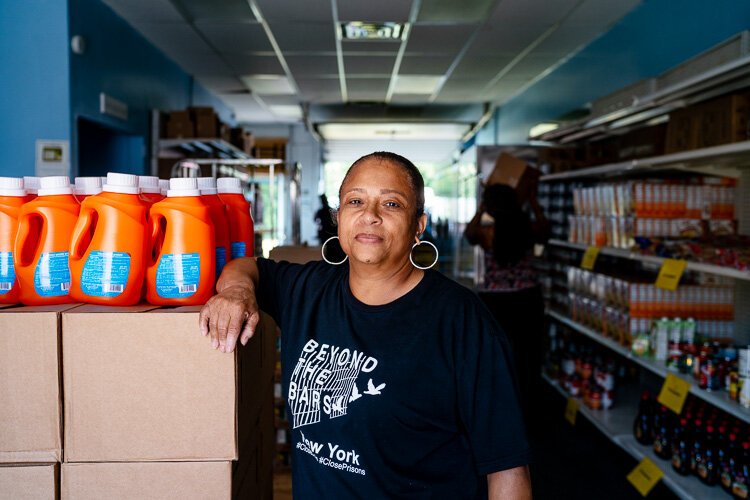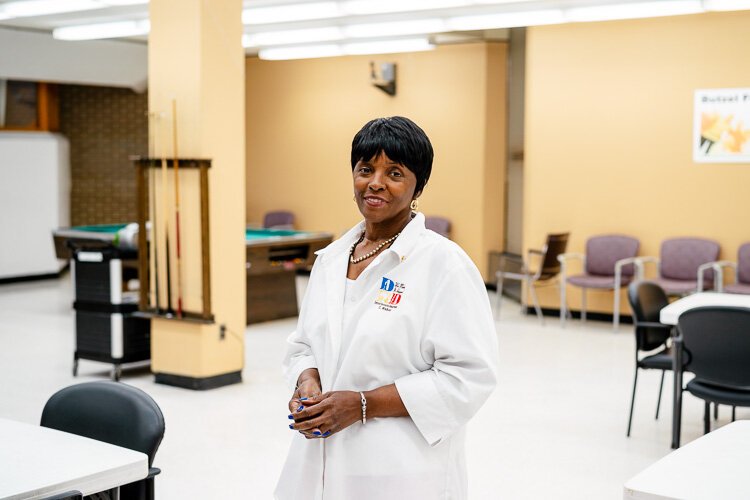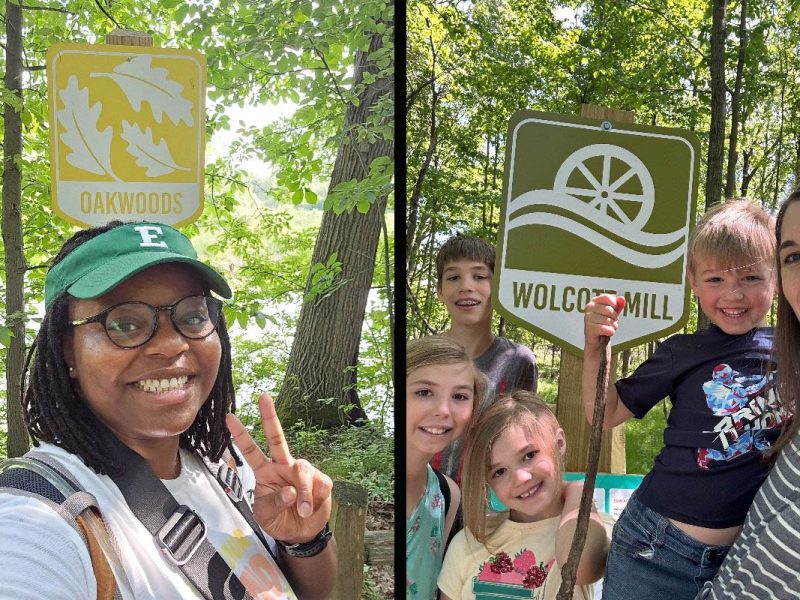Water shutoffs, power failures and other issues leave Detroit vulnerable during heatwaves
Even though the summer is winding down and average temps this summer weren’t as scorching as years past, the reality is that climate change is contributing to higher temps in general, making this a year-round issue in terms of the design and cultural changes needed to live in this new normal.
On July 19, it’s 93 degrees outside with a heat index topping 100. Despite the extreme temperatures, there is only one person “cooling” at the Butzel Family Center on Kercheval near Van Dyke, one of the city’s designated cooling centers. Another visitor says she has air conditioning at home, but the center’s pool table is what brought her here.
Why aren’t there more people trying to cool off on one of the hottest days of the summer?
“Most of the time the hindrance is transportation,” says Cecilia Walker, the general manager for East Side Operations with Detroit’s Parks and Recreation Department, of why there aren’t more people at the cooling center on this especially brutally hot day.
The Rev. Roslyn Bouier, who runs the Brightmoor Connection Food Pantry, agrees. “You have to get there, right?” Bouier says. “…we know that mass transit is not what it used to be in the city of Detroit.” Although the city expanded bus service in 2018 and has a plan to make further improvements, Bouier says this hasn’t been targeted at neighborhoods like Brightmoor. In addition to lack of access to reliable public transportation, a third of Detroiters lack access to a car.
“And then when you add on the fact that there’s no cooling centers per se, but there’s a couple of churches that are open in Brightmoor, there’s not a lot,” she says.
Even though the summer is winding down and average temps this summer weren’t as scorching as years past, the reality is that climate change is contributing to higher temps in general, making this a year-round issue in terms of the design and cultural changes needed to live in this new normal.
A recent article by the Washington Post that analyzed temperature data showed that since the late 19th-century average temperature increases for major areas have crossed the 2 degree Celsius mark, a “critical threshold for global warming.” The average temperature change for Wayne County was 1.5 degrees Celsius.
The problem gets compounded by factors such as the lack of city infrastructure, power failures, lack of air conditioning, and other social vulnerabilities along with warming trends that mean severe heatwaves will become more frequent.
It’s also an equity issue: Poor neighborhoods and communities of color like Brightmoor are often disproportionately affected because they are more likely to face these vulnerabilities. For Bouier, the number of cooling centers isn’t as pressing an issue as the water shutoffs affecting her neighborhood, which she describes as “one of the most disenfranchised communities in the city.”
She says the city continued to shut off people’s water for nonpayment during the heatwave and that organizations like hers are unable to keep up with the demand from hundreds of people for bottled water just in Brightmoor. Bouier says her pantry has been giving out around 50 cases of water a week, but could easily be giving out that much every day. Bryan Peckinpaugh, Deputy Director of Public Affairs for the Detroit Water and Sewerage Department (DWSD), confirmed that water shutoffs continued uninterrupted throughout the heat of the summer.
Bouier says water shutoffs make people reluctant to seek help for a number of reasons, including the threat of having their children taken away if it’s discovered there is no water in the house. “When you have no water, you’re going to be skeptical of going to any of these (cooling centers),” she says. Bouier adds that without water, people are concerned about hygiene. “People whose water’s shut off live in the shadows.”
Additionally, Carina Gronlund, an epidemiologist at the University of Michigan’s Institute for Social Research, says, “one of the ways that people report that they keep themselves cool when it’s hot outside — particularly if they don’t have air conditioning — is to take lots of showers.”
Taking action
To help people beat the heat, the city’s current response plan entails activating recreation centers and libraries to serve as cooling centers. If extreme heat persists, recreation center hours are extended and possibly converted into overnight accommodations, according to the Detroit Health Department. The public is notified by press release, social media, and other communication channels like the website.
The city earlier this summer released the Sustainability Action Agenda, which addressed climate change and measures that can help mitigate the effects of climate change and being an urban heat island (a built-up area that is hotter than rural areas, typically cities that are mostly concrete, asphalt, and steel).
According to the agenda, targeted tree planting is a priority in parts of the city that are vulnerable to heatwaves. In 2017, the city announced its plan to plant 10,000 trees over three years to replace trees damaged by disease and emerald ash borer as well as those that were too old. So far, 2,350 trees have been planted and the goal is to plant all 10,000 by 2021.
The Detroit Climate Action Plan (DCAP) put out by Detroiters Working for Environmental Justice in 2017 suggests using tree planting, green infrastructure, and other passive cooling techniques to address the urban heat island effect, which contributes to heatwave severity. It also urges the city to invest more in planning for emergency response based on vulnerability maps developed in the plan.
Sandra Turner-Handy from the Michigan Environmental Council, who worked on the DCAP, says it should be “an integral part of the Sustainability Agenda.” However, in the past Joel Howrani Heeres, director of Detroit’s Office of Sustainability, has stressed the importance of integrating disaster planning into existing protocols across city departments.
However the heat plan is rolled out, the city will have to deal with a number of issues during extreme heat, with energy reliability high up the list of potential dangers.
“Air conditioning prevalence is relatively low in Detroit,” Gronlund says. Low-income residents are less likely to be able to afford air conditioning. But even those who have air conditioners might be in trouble if there is a power failure. Outages are likely to become more common during heat events and air conditioning itself increases the pressure on the electrical grid. Power failures would also make it impossible to use fans and close cooling centers and libraries unless they had backup power.
According to the Detroit Health Department, city recreation centers have limited generator backup power but not enough to power air conditioning systems. In a response to Model D, Jeremy Thomas, communications and digital media coordinator for the Detroit Health Department, says, “In the event of a large scale blackout during a heatwave, police precincts would be able to serve as cooling centers.” The city’s proposal to use police precincts for cooling is complicated by things like recent racist incidents among Detroit police officers in a predominantly African American city.
Eric Klinenberg, director of New York University’s Institute for Public Knowledge and author of the book “Heatwave” – which covers the lethal 1995 Chicago heat event – does not mince words when responding to this proposal, “If this is Detroit’s plan, what that tells me is Detroit is not planning.”
Making this problem more acute is Michigan’s recent track record with blackouts. About 600,000 people in Michigan lost power as a result of the storms that followed July’s heatwave, with Detroit and southeast Michigan getting hit especially hard. Many people were without power for four or five days and this wasn’t an isolated occurrence. A recent study by the Citizens Utility Board of Michigan found that the state is ranked near the bottom of states in the time it takes to restore power after an outage.
But the most serious consequence of extreme heat is illnesses and fatalities. A 2019 study led by Gronlund shows that more people will die as a result of extreme weather in Michigan if nothing is done to protect them.
Klinenberg’s book found that “eight of the ten community areas with the highest death rates were virtually all African American, with pockets of concentrated poverty and violent crime … But that’s not the whole story.”
Klinenberg found that an important difference in survivability lay in a neighborhood’s “social infrastructure: the sidewalks, stores, public facilities, and community organizations that bring people into contact with friends and neighbors.” Neighborhoods that did better seemed to have more of this social infrastructure, even if they resembled harder hit neighborhoods in most other ways.
The city’s Sustainability Action Agenda seems to acknowledge that more needs to be done to create housing and neighborhoods that can respond to environmental stressors like heatwaves, addressing them with an emphasis on transportation and home energy efficiency. This could also entail addressing the water shutoffs that have afflicted neighborhoods like Brightmoor, which might help rebuild trust in communities where people are skeptical of the city’s willingness or ability to help. (Recently, Chicago mayor Lori Lightfoot suspended that city’s water shutoffs.)
“If the city’s not concerned about these children and the elderly and the people with phase three and four cancer not having water,” Bouier says, “they’re not going to be concerned about them having a cooling station…”









